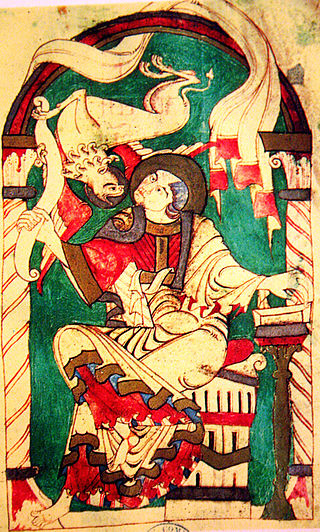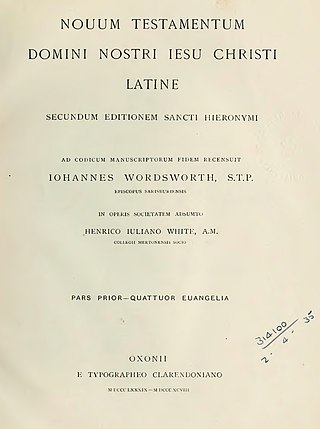The Codex Sangermanensis II, designated by g2 or 29 (in Beuron system [1] ), is a 10th-century Latin manuscript of the New Testament. The text, written on vellum, is a version of the Latin. [2]
The manuscript contains text of the four Gospels on 166 parchment leaves (21.5 x 14 cm). [3]
The Latin text of the Gospels is a mixed of Old Latin and Vulgate. [4]
It was examined by Samuel Berger, Paul Sabatier, and John Wordsworth. Sabatier published its text. [2] Currently it is housed at the National Library of France (fond lat. 13169) in Paris. [2]

The Vulgate, sometimes referred to as the Latin Vulgate, is a late-4th-century Latin translation of the Bible.

The Codex Amiatinus is considered the best-preserved manuscript of the Latin Vulgate version of the Christian Bible. It was produced around 700 in the northeast of England, at the Benedictine Monkwearmouth–Jarrow Abbey in the Kingdom of Northumbria, now South Tyneside, and taken to Italy as a gift for Pope Gregory II in 716. It was one of three giant single-volume Bibles then made at Monkwearmouth–Jarrow, and is the earliest complete one-volume Latin Bible to survive, only the León palimpsest being older. It is the oldest Bible where all the biblical canon present what would be their Vulgate texts.

Codex Claromontanus, symbolized by Dp, D2 or 06 (in the Gregory-Aland numbering), δ 1026 (von Soden), is a Greek-Latin diglot uncial manuscript of the New Testament, written in an uncial hand on vellum. The Greek and Latin texts are on facing pages, thus it is a "diglot" manuscript, like Codex Bezae Cantabrigiensis. The Latin text is designated by d (traditional system) or by 75 in Beuron system.
Codex Colbertinus, designated by 6 or c, is a Latin manuscript of the Bible. Its version of the four Gospels and Book of Acts follows the Vetus Latina, while the rest of the New Testament follows the Vulgate. It was written in the 11th or 12th century, probably in southern France.
The Garland of Howth, also known as the Codex Usserianus Secundus, designated by r2 or 28, is a fragmentary 8th to 10th century Latin Gospel Book now in Trinity College Dublin as MS. 56.

The Codex Corbeiensis I, designated by ff1 or 9, is an 8th, 9th, or 10th-century Latin New Testament manuscript. The text, written on vellum, is a version of the old Latin. The manuscript contains 39 parchment folios with the text of the four Gospels, Acts of the Apostles, and General epistles.
The Codex Corbeiensis II, designated by ff2 or 8, is a 5th-century Latin Gospel Book. The text, written on vellum, is a version of the old Latin. The manuscript contains 190 parchment folio with the text of the four Gospels with lacunae. Written in a beautiful round uncial hand.
The Codex Sangermanensis I, designated by g1 or 7, is a Latin manuscript, dated AD 822 of portions of the Old Testament and the New Testament. The text, written on vellum, is a version of the Latin. The manuscript contains the Vulgate Bible, on 191 leaves of which, in the New Testament, the Gospel of Matthew contain Old Latin readings. It contains Shepherd of Hermas.
The Codex Complutensis I, designated by C, is a 10th-century codex of the Christian Bible. It is written on vellum with Latin text mainly following the Vulgate. Parts of the Old Testament present an Old Latin version.

The Codex Claromontanus V, designated by h in traditional system or by 12 in the Beuron system, is a 4th or 5th century Latin manuscript of the New Testament. The text, written on vellum.
The Codex Floriacensis, designated by h in traditional system or by 55 in the Beuron system, is a 6th-century Latin manuscript of the New Testament. The text, written on vellum, is a palimpsest. Another name of the manuscript is Fleury Palimpsest or Palimpsestus Floriacensis. It is one of the eight Old-Latin manuscripts with text of Apocalypse.
The Codex Gatianum, designated by gat or 30, is an 8th-century Latin manuscript of the New Testament. The text, written on vellum, is a version of the Old Latin.

The Codex Toletanus, designated by T, also called Biblia hispalense or Seville Bible, is a 10th-century Latin manuscript of the Old and New Testament. The text, written on vellum, is a version of the Latin Vulgate Bible, which contains the entire Bible, including the trinity reference Comma Johanneum.
The Codex Theodulphianus, designated Θ, is a 10th-century Latin manuscript of the Old and New Testament. The text, written on vellum, is a version of the Latin Vulgate Bible. It contains the whole Bible, with some parts written on purple vellum.
The León Palimpsest, designated l or 67, is a 7th-century Latin manuscript pandect of the Christian Bible conserved in the cathedral of León, Spain. The text, written on vellum, is in a fragmentary condition. In some parts it represents the Old Latin version, while following Jerome's Vulgate in others. The codex is a palimpsest.

The Codex Sangallensis 907, designated S, is an 8th-century Latin manuscript of the New Testament. The text, written on vellum, is a version of the Latin Vulgate Bible. It contains the text of the Catholic epistles, Book of Revelation, and non-biblical material. The manuscript did not survived in a complete condition and some parts of it has been lost. The codex contains the Comma Johanneum.

The Oxford Vulgate is a critical edition of the Vulgate version of the New Testament produced by scholars of the University of Oxford, and published progressively between 1889 and 1954 in 3 volumes.
Textual variants in the First Epistle to the Thessalonians are the subject of the study called textual criticism of the New Testament. Textual variants in manuscripts arise when a copyist makes deliberate or inadvertent alterations to a text that is being reproduced. An abbreviated list of textual variants in this particular book is given in this article below.

The Vulgate is a late-4th-century Latin translation of the Bible, largely edited by Jerome, which functioned as the Catholic Church's de facto standard version during the Middle Ages. The original Vulgate produced by Jerome around 382 has been lost, but texts of the Vulgate have been preserved in numerous manuscripts, albeit with many textual variants.

Vetus Latinamanuscripts are handwritten copies of the earliest Latin translations of the Bible, known as the "Vetus Latina" or "Old Latin". They originated prior to Jerome from multiple translators, and differ from Vulgate manuscripts which follow the late-4th-century Latin translation mainly done by Jerome.